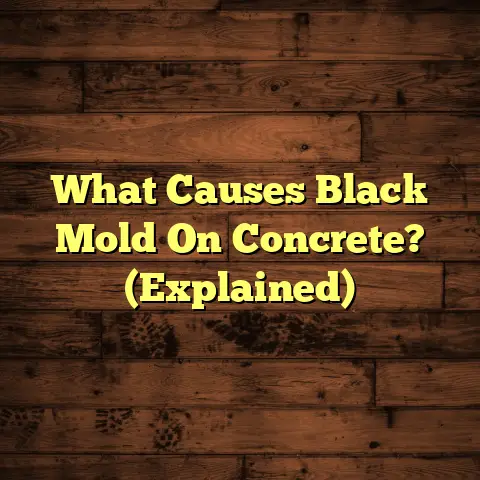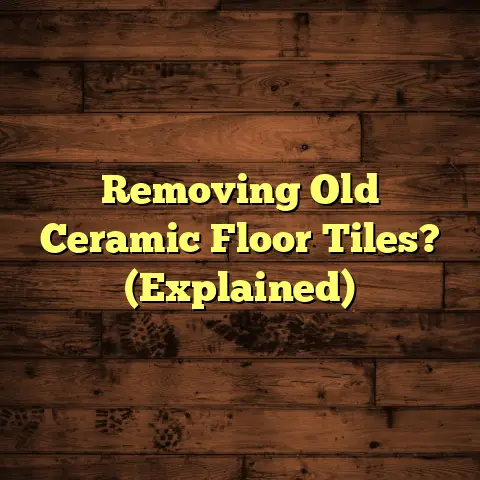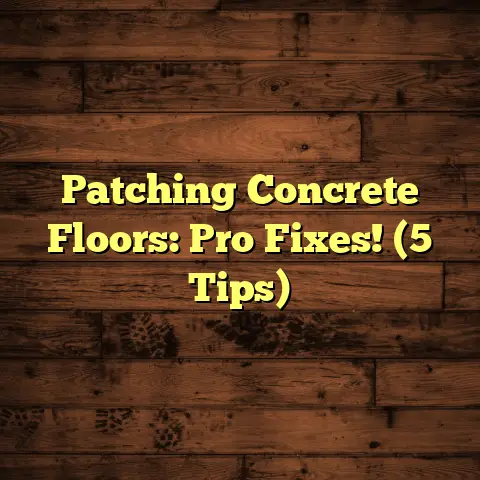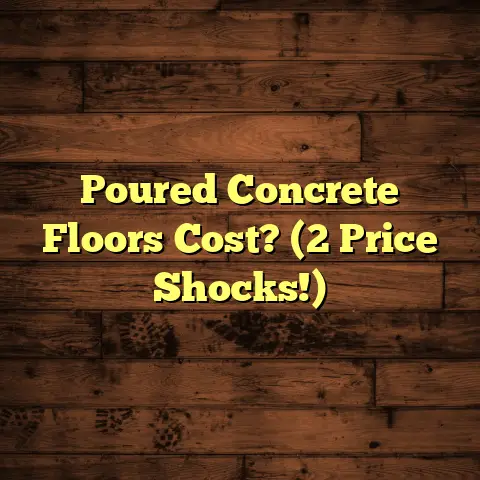Prep Floor For Self Leveling (7 Steps Missing?)
From warped wood to cracked tiles, I’ve wrestled with every kind of flooring nightmare.
And one thing I’ve learned?
The key to a flawless floor isn’t just the material.
It’s all about the prep work. Especially when you’re dealing with self-leveling compounds.
Trust me, I’ve seen too many eager DIYers skip crucial steps and end up with a lumpy, uneven mess.
So, let’s dive into the nitty-gritty of preparing your floor for self-leveling like a pro.
Setting the Scene: A Trendsetter’s Choice
Imagine this: a sleek, modern loft.
Sunlight streams through massive windows, illuminating clean lines and minimalist decor.
And underfoot? A perfectly smooth, polished concrete floor.
That’s the magic of self-leveling compounds.
They’ve become the go-to choice for achieving that
flawless, contemporary look that everyone craves.
Think polished concrete, luxurious vinyl tiles, or even seamless epoxy coatings.
But here’s the kicker: that stunning finish is only as good as the foundation beneath it.
If you skimp on the prep work, you’re setting yourself up for a world of disappointment.
I’m talking cracks, bubbles, and uneven surfaces that’ll make you want to tear your hair out.
So, let’s do it right, shall we?
The 7 Steps to Prepare Your Floor for Self-Leveling
Alright, buckle up.
We’re about to get down and dirty with the seven essential
steps for prepping your floor for self-leveling.
I’ve seen these steps overlooked time and time again, leading to costly mistakes and headaches.
Don’t be one of those people.
Follow these steps, and you’ll be well on your way to a
perfectly smooth, professional-looking floor.
1. Assessment of the Existing Floor
First things first: let’s play detective.
Grab a flashlight and get down on your hands and knees.
We need to thoroughly inspect the existing floor.
What are we looking for? Cracks, holes, unevenness, and any other imperfections.
Pro Tip: Use a straight edge and a level to identify any significant dips or rises.
Trust me, these little details can make a huge difference.
Also, what type of flooring are we dealing with?
- Concrete: Is it smooth or rough?
Are there any signs of spalling or crumbling? - Tile: Are any tiles loose or cracked?
- Wood: Is it solid hardwood or plywood?
Is it warped or damaged by moisture?
The type of existing flooring will influence how you prepare the surface for self-leveling.
Real Talk: I once worked on a project where the homeowner swore the concrete floor was “perfectly fine.”
Turns out, there were hairline cracks hidden beneath layers of old paint that caused the self-leveling compound to fail.
Don’t make the same mistake. Assess, assess, assess!
2. Cleaning the Surface
Okay, detective work is done! Now, it’s time to get your hands dirty.
A clean surface is absolutely crucial for the self-leveling compound to adhere properly.
Think of it like painting: you wouldn’t paint over a dirty wall, would you?
The same principle applies here.
Any dust, dirt, grease, old adhesives, or loose debris
can interfere with the bonding process, leading to a weak or uneven finish.
So, how do we clean the floor? Here’s my go-to method:
- Sweep or Vacuum: Start by removing any loose debris.
A good shop vacuum with a brush attachment is your best friend here. - Scrub with a Degreaser: Use a heavy-duty degreaser to remove any grease or oil stains.
I personally like Simple Green or Krud Kutter. - Rinse Thoroughly: Make sure to rinse the floor thoroughly with clean water to remove any residue from the degreaser.
- Remove Old Adhesives: If there are any old adhesives or glue, you’ll need to remove them.
A scraper or a chemical adhesive remover can do the trick. - Final Vacuum: Do one last vacuum to ensure every single debris is gone.
Important Note: Don’t use soap or detergents.
They can leave behind a residue that can interfere with the bonding process.
3. Repairing Damage
Alright, the floor is clean. Now, let’s fix any damage.
Those cracks and holes we identified in step one? It’s time to address them.
Why is this important?
Because self-leveling compounds aren’t designed to fill large voids or bridge cracks.
If you try to pour self-leveler over a damaged floor, you’ll likely end up with cracks reappearing or the compound sinking into the holes.
Here’s how to tackle common types of damage:
-
Cracks: For small hairline cracks, you can use a concrete crack filler.
For larger cracks, you may need to widen them slightly and fill them with a concrete patching compound.My Recommendation: Use a flexible crack filler
that can accommodate slight movement in the floor.
* Holes: Fill holes with a concrete patching compound or a self-leveling underlayment.
For deep holes, you may need to fill them in layers, allowing each layer to dry before applying the next.Pro Tip: Before applying the patching compound,
prime the inside of the hole with a concrete bonding adhesive.
* Uneven Surfaces: If there are any significant dips or rises in the floor,
you can use a self-leveling underlayment to even them out.Important Note: Follow the manufacturer’s instructions
carefully when using a self-leveling underlayment.
4. Creating a Moisture Barrier
This step is especially critical if you’re working in a basement or any area prone to dampness.
Moisture can wreak havoc on your self-leveling compound, causing it to bubble, crack, or even fail completely.
A moisture barrier prevents moisture from rising through the concrete slab and damaging the flooring.
There are two main types of moisture barriers:
- Liquid Membranes: These are applied like paint and create a waterproof layer on the floor.
I like using a two-part epoxy moisture barrier for its superior protection. - Sheet Barriers: These are rolled out over the floor and taped together at the seams.
Polyethylene sheeting is a common and affordable option.
How to Apply a Liquid Moisture Barrier:
- Make sure the floor is clean and dry.
- Apply the primer recommended by the manufacturer.
- Mix the two parts of the epoxy according to the instructions.
- Apply the epoxy evenly with a roller or brush.
- Allow the epoxy to cure completely before moving on to the next step.
My Experience: I once skipped the moisture barrier on a basement floor because the homeowner insisted it was “dry as a bone.”
A few months later, the self-leveling compound started to bubble and peel.
Turns out, there was a hidden leak in the foundation.
Lesson learned: always use a moisture barrier in damp environments!
5. Installing a Primer
Think of primer as the glue that holds everything together.
It creates a strong bond between the existing floor and the self-leveling compound, ensuring a long-lasting and durable finish.
Why is primer so important?
- Improves Adhesion: Primer helps the self-leveling compound grip the floor better, preventing it from peeling or cracking.
- Reduces Air Bubbles: Primer seals the pores in the concrete, preventing air from escaping and creating bubbles in the self-leveling compound.
- Controls Absorption: Primer helps to control the absorption rate of the concrete, ensuring that the self-leveling compound dries evenly.
There are different types of primers available, so it’s important to choose one that’s compatible with your self-leveling compound.
My Go-To Primers:
- Acrylic Primers: These are water-based primers that are suitable for most concrete surfaces.
- Epoxy Primers: These are two-part primers that offer superior adhesion and moisture resistance.
- Concrete Bonding Adhesives: These are specifically designed to improve the bond between concrete surfaces.
Application is Key:
- Apply the primer evenly with a roller or brush.
- Make sure to cover the entire surface.
- Allow the primer to dry completely before applying the self-leveling compound.
6. Setting Up the Area
Okay, we’re almost ready to pour!
But before we do, let’s take a moment to prepare the workspace.
This step is all about minimizing distractions and ensuring a smooth and efficient application process.
Here’s what you need to do:
- Remove Furniture: Clear the entire area of furniture and other obstacles.
- Cover Vents: Cover any vents or openings to prevent the self-leveling compound from flowing into unwanted areas.
- Protect Walls: Protect the walls with plastic sheeting or painter’s tape.
- Ensure Proper Ventilation: Open windows and doors to provide adequate ventilation.
Self-leveling compounds can release fumes, so it’s important to work in a well-ventilated area. - Temperature Control: Most self-leveling compounds require a specific temperature range for proper curing.
Check the manufacturer’s instructions and adjust the temperature accordingly.
My Horror Story: I once forgot to cover a floor vent, and the self-leveling compound flowed down into the ductwork.
It took me hours to clean it out!
Learn from my mistakes and take the time to properly prepare the area.
7. Mixing and Pouring the Self-Leveling Compound
Alright, the moment of truth!
We’re finally ready to mix and pour the self-leveling compound.
This is where precision and attention to detail are paramount.
Follow these steps carefully, and you’ll be well on your way to a perfectly smooth floor.
Mixing the Compound:
- Read the Manufacturer’s Instructions: This is non-negotiable.
Each self-leveling compound has its own specific mixing requirements. - Use the Right Tools: You’ll need a large bucket, a mixing paddle, and a powerful drill.
- Add Water Gradually: Pour the water into the bucket first, then slowly add the powder while mixing continuously.
- Mix Thoroughly: Mix the compound for at least 3-5 minutes, until it’s completely smooth and lump-free.
The consistency should be similar to pancake batter. - Don’t Overmix: Overmixing can introduce air bubbles into the compound.
Pouring the Compound:
- Work in Sections: Pour the compound in manageable sections, starting in the deepest part of the floor.
- Pour Evenly: Pour the compound evenly, allowing it to flow and self-level.
- Use a Gauge Rake: A gauge rake helps to spread the compound evenly and control the thickness.
- Pop Air Bubbles: Use a spiked roller to remove any air bubbles that may appear.
- Work Quickly: Self-leveling compounds have a limited working time, so you’ll need to work quickly and efficiently.
My Biggest Tip: Have a helper!
Mixing and pouring self-leveling compound is a two-person job.
One person can mix the compound while the other pours and spreads it.
Recap and Anticipation for the Next Step
Wow, we made it!
We’ve covered the seven essential steps for preparing your floor for self-leveling, from assessing the existing floor to mixing and pouring the compound.
Now, all that’s left to do is wait.
Allow the self-leveling compound to set and harden according to the manufacturer’s instructions.
This can take anywhere from 24 to 72 hours, depending on the product and the environmental conditions.
Once the compound is fully cured, you’ll have a beautifully smooth surface that’s ready for your final flooring finish.
Whether you’re planning to install polished concrete, luxury vinyl tiles, or any other type of flooring, you can rest assured that you’ve laid the foundation for a stunning and long-lasting result.
So, congratulations!
You’ve taken the first step towards creating the floor of your dreams.
Go ahead and pat yourself on the back.
You’ve earned it!





